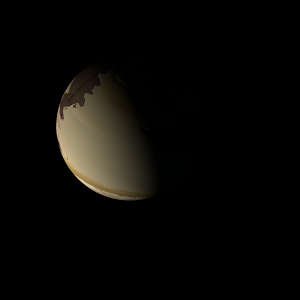|
|
Space Astro
|
Info for exoplanet "Engai"
| Scientific (actual) data |
|---|
| Name | Kepler-401 d |
| Planet status | Confirmed |
| Radius | 0.203 |
| Orbital period | 184.256 |
| Discovered | 2016 |
| Updated | 2021-02-05 |
| Tconj | 2455090 |
| Publication | Announced on a website |
| Detection type | Primary Transit |
| Alternate names | 2MASS J19201985+5051485 d, K02714.03, KIC 12206313 d, KOI-2714 d, KOI-2714.03, WISE J192019.85+505148.4 d |
| Star name | Kepler-401 |
| Right ascension | 290.08° |
| Declination | 50.86° |
| Mag j | 12.277 |
| Mag h | 12.065 |
| Mag k | 11.987 |
| Star distance | 993.14 |
| Star metallicity | -0.297 |
| Star radius | 1.33 |
| Star temperature | 6117 |
| Star alternate names | 2MASS J19201985+5051485, KIC 12206313, KOI-2714, WISE J192019.85+505148.4 |
| Wikipedia article | Kepler-401 d |
Back
| |
| Fictional info (?) |
|---|
| Suggested name | Engai |
| Planet type | Cold planet |
| A prominent result is the "great orange spot", a giant storm that is known to have existed for centuries since it was first seen by telescope. |
| Atmosphere | Ethane | 89% |
| Sulfur dioxide | 5.3% |
| Hydrogen peroxide | 2.8% |
| Nitrogen | 2.7% |
| Atmospheric pressure | 0.08 bar |
 |
| Moon | Ozwa-swach Eqang | Huge irregular rocky asteroid |
| Anxyu Shyo | Small round gaseous moon |
| Wujot'yingch | Very small potato shaped gaseous asteroid |
| Google search for Engai |
|
Website by Joachim Michaelis
|
|
|
|